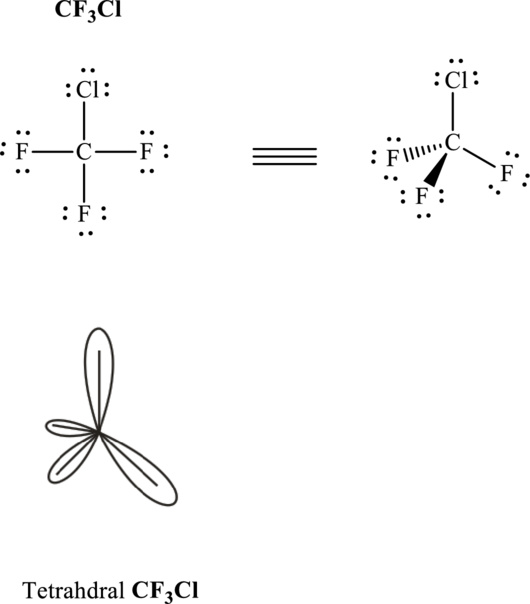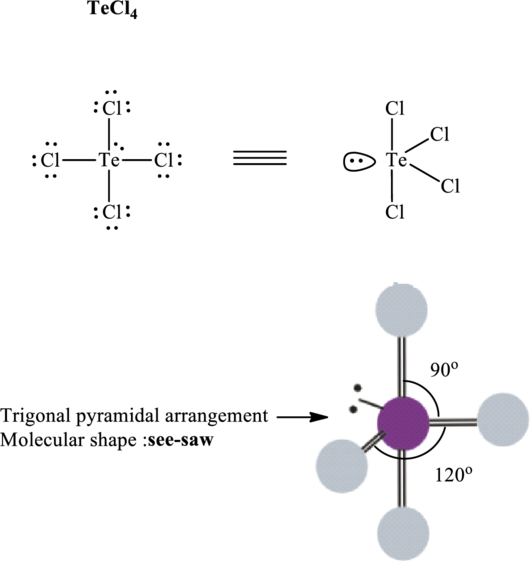
Concept explainers
(a)
Interpretation:
Lewis structure, VSEPR formula, bond angle, and molecular shape for
Concept Introduction:
Valence Shell Electron Pair Repulsion model predicts shape by inclusion of bond angles and most distant arrangement of atoms that leads to minimum repulsion. For the molecules that have no lone pairs around the central atom the bonded-atom unshared -pair arrangement is decided by the table as follows:
In order to determine the shape the steps to be followed are indicated as follows:
- 1. Lewis structure of molecule should be written.
- 2. The type electron arrangement around the central atom should be identified around the central atom. This essentially refers to determination of bond pairs and unshared or lone pairs around central atoms.
- 3. Then bonded-atom unshared -pair arrangement that can maximize the distance of electron pairs about central atom determines the shape.
For molecules that have lone pairs around central atom, lone pairs influence shape, because there are no atoms at the positions occupied by these lone pairs. The key rule that governs the molecular shape, in this case, is the extent of lone –lone pair repulsions are far greater than lone bond pair or bond pair-bond pair repulsions. The table that summarized the molecular shapes possible for various combinations of bonded and lone pairs are given as follows:
(a)
Answer to Problem 2E.15E
The shape for
Explanation of Solution
Total valence electrons are sum of the valence electrons on each atom in
The skeleton structure in
These 12 electron pairs are allotted as lone pairs to satisfy respective octets. Hence, the Lewis structure in

It is evident that in
If central atom is represented by A, and other attached bond pairs by X, then for any tetrahedral species with no lone pairs the VSEPR formula is predicted as
(b)
Interpretation:
Lewis structure, VSEPR formula, bond angle, and molecular shape for
Concept Introduction:
Refer to part (a).
(b)
Answer to Problem 2E.15E
The shape for
Explanation of Solution
Total valence electrons are sum of the valence electrons on atom in
The skeleton structure in
These 13 electron pairs are allotted as lone pairs to satisfy respective octets. Hence, the Lewis structure in

It is evident that
One lone pair is localized on equatorial positions so as to minimize lone pair–bond pair repulsions in accordance with VSPER model. This leads see-saw shape for
If lone pairs are represented by E, central atom with A and other attached bon pairs by X, then for any see-saw species the VSEPR formula is predicted to be
(c)
Interpretation:
Lewis structure, VSEPR formula, bond angle and molecular shape for
Concept Introduction:
Refer to part (a).
(c)
Answer to Problem 2E.15E
The shape for
Explanation of Solution
Total valence electrons are sum of the valence electrons on atom in
The skeleton structure in
These 9 electron pairs are allotted as lone pairs or as multiple bonds to oxygen so as to satisfy octets. Hence, the Lewis structure in

It is evident that in
If lone pairs are represented by E, central atom with A and other attached bond pairs by X, then for any trigonal planar species the VSEPR formula is predicted as
(d)
Interpretation:
Lewis structure, VSEPR formula, bond angle and molecular shape for
Concept Introduction:
Refer to part (a).
(d)
Answer to Problem 2E.15E
The shape for
Explanation of Solution
Total valence electrons are sum of the valence electrons on atom in
Thus, Lewis structure in

It is evident that in
Lone pair tend to be localized on apical position and so
If lone pairs are represented by E, central atom with A and other attached bond pairs by X, then for any trigonal pyramidal species the VSEPR formula is predicted as
Want to see more full solutions like this?
Chapter 2 Solutions
Chemical Principles: The Quest for Insight
- Consider the following molecules: SiH4, PH3, H2S. In each case, a central atom is surrounded by four electron pairs. In which of these molecules would you expect the bond angle to be less than 109.5? Explain your reasoning.arrow_forwardDraw the Lewis structure of HClO₃ (with minimized formal charges) and then choose the appropriate pair of molecular geometries of the two central atoms. Your answer choice is independent of the orientation of your drawn structure.arrow_forwardDraw the Lewis structure of periodate (IO₄⁻) with minimized formal charges and then determine the hybridization of the central atom.arrow_forward
- What atomic or hybrid orbitals make up the sigma bond between Si and H in silane, SiH4?arrow_forwardPredict the geometry and bond angles around atom A for molecules with the general formulas AB4, AB3E, and AB2E2, where B represents another atom and E represents an electron pair.arrow_forwardWrite the ground-state electron configuration of O2 and calculate the bond order.arrow_forward
- Describe the electron-pair geomtery and molecular geomtery around the central atom in GeBr3-arrow_forwardDraw the Lewis structure of SnF₆²⁻ and then determine the ideal bonding angle(s) of the central atom.arrow_forwardElectrons in bonds are negatively charged and therefore repel each other. If you had a molecule of formula AB 2 , with A being the central atom, what would you predict the 3D shape to be to allow maximum distance between the two B atoms bonded to A?arrow_forward
- Except for nitrogen, the elements of Group 5A(15) all form pentafluorides, and most form pentachlorides. The chlorine atoms of PCl₅ can be replaced with fluorine atoms one at a timeto give, successively, PCl₄F, PCl₃F₂, ... , PF₅. (a) Given the sizesof F and Cl, would you expect the first two F substitutions to beat axial or equatorial positions? Explain. (b) Which of the five fluorine-containing molecules have no dipole moment?arrow_forwardThe molecules SiF4, SF4, and XeF4 have molecular formulas of the type AF4, but the molecules have different molecular geometries. Predict the shape of each molecule, and explain why the shapes differ.arrow_forwardDraw the Lewis structure of SF₄ and then determine its electron domain and molecular geometries.arrow_forward
 Chemistry: Principles and ReactionsChemistryISBN:9781305079373Author:William L. Masterton, Cecile N. HurleyPublisher:Cengage Learning
Chemistry: Principles and ReactionsChemistryISBN:9781305079373Author:William L. Masterton, Cecile N. HurleyPublisher:Cengage Learning Chemistry: Principles and PracticeChemistryISBN:9780534420123Author:Daniel L. Reger, Scott R. Goode, David W. Ball, Edward MercerPublisher:Cengage Learning
Chemistry: Principles and PracticeChemistryISBN:9780534420123Author:Daniel L. Reger, Scott R. Goode, David W. Ball, Edward MercerPublisher:Cengage Learning Chemistry: The Molecular ScienceChemistryISBN:9781285199047Author:John W. Moore, Conrad L. StanitskiPublisher:Cengage Learning
Chemistry: The Molecular ScienceChemistryISBN:9781285199047Author:John W. Moore, Conrad L. StanitskiPublisher:Cengage Learning


